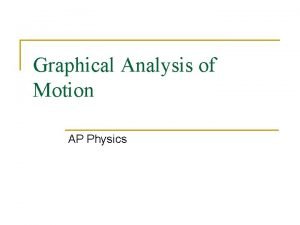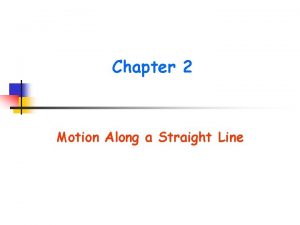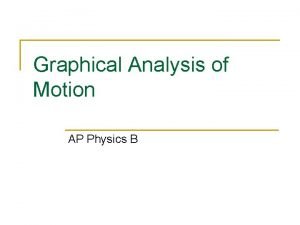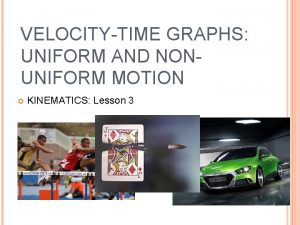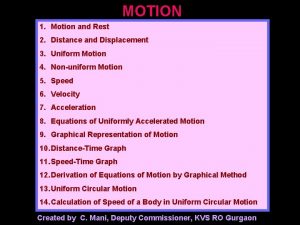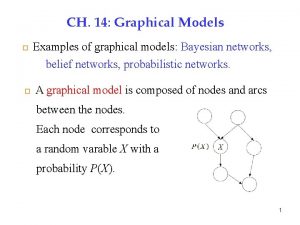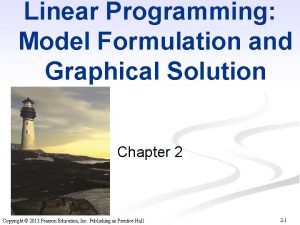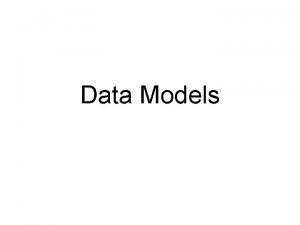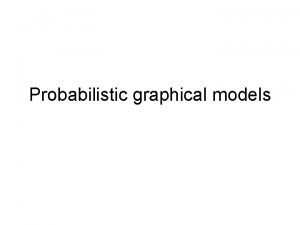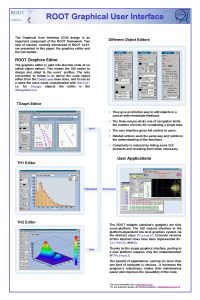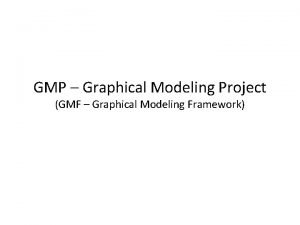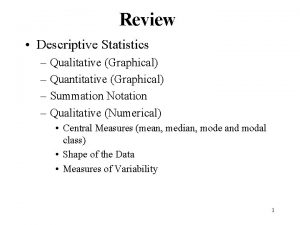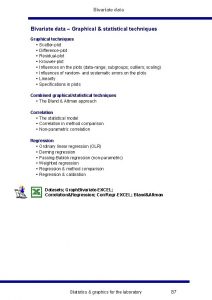Graphical Model of Motion Graphical Model of Motion

















- Slides: 17

Graphical Model of Motion

Graphical Model of Motion • • We will combine our Kinematics Equations with our Graphical Relationships to describe One Dimensional motion! We will be looking at seven graphs!

Graphs for Constant Velocity l l l Velocity = constant (Acceleration = 0) v = d/t From the equation v = d/t, make a data table with t, d, v, a. – Time is the independent variable

Displacement vs Time Graph for Constant Velocity l l d vs t is linear – y = mx +b Slope (m) from a d vs t graph is always, Velocity! Since graph is linear, slope (m) is Constant! Therefore: Velocity is Constant!!

Displacement vs Time Graph for Constant Velocity l l The y-intercept (b) = Where you are starting from when t=0! Graphing a Complete trip! – Every graph tells a story! – Time keeps going even when you are not! – We can find the Instantaneous Velocity, Average Speed and Average Velocity.

Velocity vs Time Graph for Constant Velocity l l l Since the Velocity is constant, the graph is a horizontal line (Constant Relationship) Slope of a velocity vs time graph is always acceleration! Since the slope of a horizontal line is zero and the slope is the acceleration, Therefore: acceleration = 0!

Velocity vs Time Graph for Constant Velocity l l l We can find the displacement from a velocity vs time graph by finding the Area Under the Curve! d = Area under the Curve Area will be a rectangle: – A = l x w = displacement

Acceleration vs Time Graph for Constant Velocity l l Since the acceleration = zero the graph is a horizontal line on the x-axis (a = 0). We cannot find anything from this graph!

Uniform Acceleration Graphs l l l Acceleration (a) is constant. Make a Data Table with your Kinematics Equations Looking a four graphs.

Velocity vs Time Graph for Uniform Acceleration l l v vs t is linear – y = mx +b Slope (m) from a v vs t graph is always, Acceleration! Since graph is linear, slope (m) is Constant! Therefore: Acceleration is Constant!!

Velocity vs Time Graph for Uniform Acceleration l The y-intercept (b) = Your Initial Velocity (vi). The speed you are starting with when t=0! y = mx + b becomes; l v = at + vi similar to vf = vi + at l

Velocity vs Time Graph for Uniform Acceleration l l l We can find the displacement from a velocity vs time graph by finding the Area Under the Curve! d = Area under the Curve Area will now be a triangle: – A = ½ b x h = displacement – Similar to d = ½ (vf +vi)t (starting from rest)

Displacement vs Time Graph for Uniform Acceleration l l d vs t is parabolic – y = kx 2 Slope (m) from a d vs t graph is Velocity! Since graph is parabolic, the slope is Not Constant! Therefore: Velocity is Not Constant! (The object is accelerating)

Displacement vs Time Graph for Uniform Acceleration l l l d vs t is parabolic, y = kx 2 Unit for the constant (k) is m/s 2 k = half the acceleration (1/2 a) y = kx 2 becomes; d = ½ at 2 l Similar to d = vit + ½ at 2 (Starting from rest vi = 0) l

Displacement vs Time Squared Graph for Uniform Acceleration l l Squaring the Time will straighten out the parabola and make the graph linear. d vs t 2 is linear – y = mx +b Slope (m) from a d vs t 2 graph is half the acceleration (1/2 a) Since graph is linear, slope (m) is Constant! (The acceleration is still constant)

Acceleration vs Time Graph for Uniform Acceleration Since the Acceleration is constant, the graph is a horizontal line (Constant Relationship) l We can find the change in velocity (Dv) from an acceleration vs time graph by finding the Area Under the Curve! l Dv = Area under the Curve l Area will be a rectangle: – A = l x w = change in velocity (Dv) l

 A means in physics
A means in physics It is a motion along a straight line
It is a motion along a straight line Slope
Slope Uniform speed graph
Uniform speed graph Example of uniformly accelerated motion comic strip
Example of uniformly accelerated motion comic strip What graphical model is appropriate for decision making
What graphical model is appropriate for decision making Example of graphical model
Example of graphical model Energy pyramid labeled
Energy pyramid labeled Linear programming model formulation and graphical solution
Linear programming model formulation and graphical solution Linear programming model formulation and graphical solution
Linear programming model formulation and graphical solution Linear programming formulation
Linear programming formulation Linear programming model formulation and graphical solution
Linear programming model formulation and graphical solution A data model is usually graphical.
A data model is usually graphical. Types of motion
Types of motion Shm formula
Shm formula An object in motion stays in motion
An object in motion stays in motion Chapter 2 section 1 describing motion answer key
Chapter 2 section 1 describing motion answer key Chapter 2 motion section 1 describing motion answer key
Chapter 2 motion section 1 describing motion answer key
